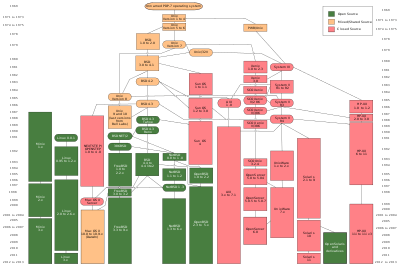Computer Systems Research Group
- CSRG may also refer to China South Locomotive and Rolling Stock Industry (Group) Corporation
- or Chauchat Sutter Ribeyrolles Gladiator World War I era machine gun.
The Computer Systems Research Group (CSRG) was a research group at the University of California, Berkeley that was dedicated to enhancing AT&T Unix operating system and funded by Defense Advanced Research Projects Agency.
History
Professor Bob Fabry of University of California, Berkeley acquired a UNIX source license from AT&T in 1974. Berkeley started to modify UNIX and distributed their version of UNIX as BSD (Berkeley Software Distribution). In April 1980 Professor Fabry signed a contract with the Defense Advanced Research Projects Agency to develop UNIX even further to accommodate the specific requirements of the ARPAnet. With funding from DARPA, Fabry created the Computer Systems Research Group. The BSD Sockets API and Berkeley Fast File System are some of the most noteworthy innovations of the group. The sockets interface solved the problem of supporting multiple protocols (e.g. XNS and TCP/IP), and also extended UNIX's "everything is a file" notion to these network protocols, while the fast file system increased the block allocation size from 512 bytes to 4096 bytes (or larger), improving disk transfer performance, while also allowing "micro-blocks" as small as 128 bytes, which improved disk utilization. Another noteworthy contribution was the job control signals, which allowed a user to suspend a job with a key-press (control-Z), and then continue running the job in the background under the C shell.
Noteworthy versions of BSD were 3.0 BSD (the first version of BSD to support virtual memory), 4.0 BSD (which included the job-control CTRL-Z functionality, to suspend and restart a running job), a special 4.15 (interim) BSD version which had been released using BBN's TCP/IP, and 4.2 BSD (which included a full Berkeley sockets TCP/IP stack, the fast file system, and NFS support.)
By the early 1980s CSRG was the best-known noncommercial Unix developer, and a majority of Unix sites used at least some Berkeley software. AT&T included some CSRG work in Unix System V.[1] During the 1970s and 1980s, AT&T/USL raised the commercial licensing fee for UNIX from $20,000 to $100,000–$200,000. This became a big problem for small research labs and companies who used BSD and the CSRG set up a goal for themselves to replace all the source code that originated from AT&T. They succeeded in 1994, but AT&T didn't agree and took Berkeley to court. After the settlement in 1994, CSRG distributed its last versions, called 4.4BSD-Lite (BSD-licensed) and 4.4BSD-Encumbered (UNIX-licensed).
The group was disbanded in 1995, though not without leaving a legacy - 386BSD, NetBSD, FreeBSD, OpenBSD and DragonFly BSD and are all based on the 4.4BSD-Lite distribution and continue to play an important role in the open-source UNIX community today, including dictating the style of C programming used via KNF in the style man page.
Together with the Free Software Foundation and Linux, the CSRG laid the foundations of the contemporary open source community.
Noted former members of the CSRG include Keith Bostic, Bill Joy, Marshall Kirk McKusick, Samuel J Leffler and Michael J. Karels among others.[2] The corporations Sun Microsystems, Berkeley Software Design and Sleepycat Software (later acquired by Oracle) can be considered spin-off companies of CSRG. Berkeley Software Design was led by Robert Kolstad, who led the development of BSD Unix for supercomputers at Convex Computer.
See also
References
- ↑ Fiedler, Ryan (October 1983). "The Unix Tutorial / Part 3: Unix in the Microcomputer Marketplace". BYTE. p. 132. Retrieved 30 January 2015.
- ↑ "The Computer Systems Research Group 1979 — 1993".
External links
- The Computer Systems Research Group 1979 — 1993
- A more detailed article
- Marshall Kirk McKusick. "Twenty Years of Berkeley Unix - From AT&T-Owned to Freely Redistributable". O'Reilly Media. Retrieved 2008-09-25.
